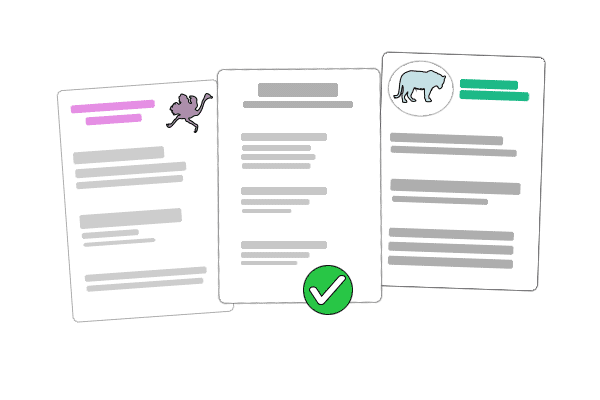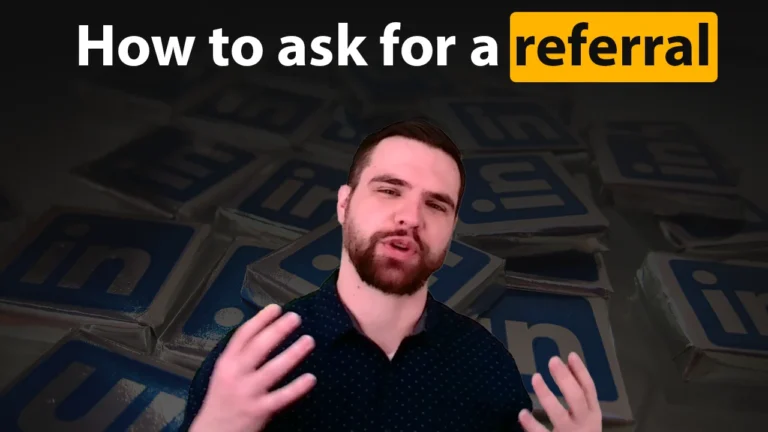One of the most critical parts of finding a job (especially in this virtual environment) is your resume. Yet this is something that’s commonly overlooked in traditional school curriculum. A simple search will reveal a mountain of general resume information but you will rarely come across advice specific to junior developers and new grads seeking employment in software industry.

My experience: over the years I’ve applied to countless jobs and internships as a junior Software Engineer. Throughout that process I paid careful attention to my resume performance. Also I got feedback from engineers involved in the hiring process and listened carefully when HR offered resume tips.
Let me share what I’ve learned:
Prefer to watch a video instead?
Formatting – it’s a big deal
Your resume should be one page and one page only (Letter/A4 8.5×11 inches page). Pretty much no exceptions here for junior engineers. Only include things that are significant for this role. You would not be applying for an entry level position (or an internship) if you had 2 pages worth of applicable experience.
Styling is not how you’re going to stand out: Keep it simple. Mostly monotone. Keep it consistent. All titles should look the same, front sizes should be consistent. Capitalization should be uniform. Bad punctuation will make you look bad.
Dates are very important. Include them and be consistent.
Stick to consistent format when describing your projects and work experience. For instance, if you start with a company name in your first job description – do the same for all job experiences.
Punctuation, capitalization, and spelling are also important. Make sure you spell check your work and get as many eyes on your resume as possible before finalizing the wording.
Did I mention consistency?
Your Resume Header
Provide your first and last legal name top and center of your resume. Make it bold. If you have a nickname, include it in parenthesis following your first name. You can include a desired role below your name if you want. This is not a requirement and may help your recruiter but should only be used when you have plenty of extra space to spare.

Below your name, include your email and phone. Ensure your email is professional – no gamergal@bzzt.net – and matches your email used in your job application. I encourage you to include your LinkedIn, portfolio, and GitHub links. Make your links clickable and don’t make your recruiter look you up (because they will!).
Lastly, you may optionally include your location but do not include your full address. Just include your city and state. This part will be appreciated by a recruiter but can be omitted to save space.
Education Section
Include following details: university name, degree/program/major/minor, academic honors (if applicable), location, GPA (if above 3.0), and graduation date.
You may list applicable courses if you have extra space to fill.
Work Experience Section
This section may include internships, freelancing, and really-large projects. List company name, position title, role description is optional and only helpful if your job title is confusing. Include dates (Month, Year – Month, Year) and location (City, State).
Let’s make your bullets stand out!
You should have 3 to five bullet points for each work experience. Each bullet point should focus on describing what you did, why you did it, and what the impact of that action was. Details are important and including specific name brands may be useful.
Let’s look at some examples:
- Not great: Looked at crash test data and generated reports
- A bit better: Analyzed crash test data points utilizing Splunk
- Much better: Analyzed critical crash test data – utilizing Splunk – to improve safety; added 1 start NTSH rating of Model T via Python magic
Which version of a bullet point would you prefer to read if you were hiring?
Should I mention this..? if you’re listing it on your resume – be prepared to speak about it in depth during your interview.
Other Sections
This last section can be a variety of projects, volunteer experiences, or leadership roles. Any unpaid work will go here. This section is optional and I have been rarely asked about of this during an interview after I had my first internship. But it is a good space to showcase your skills outside of work and education sections.
Projects
Only include projects that are substantial. I would avoid including any small projects that are not very impressive or have been done by your whole class.
Volunteer Experience
This does not have to be technical, but I would strongly recommend that you prioritize technical volunteering experiences on your resume when applying for a tech job.
Leadership Roles
Great section to showcase your involvement in clubs and organizations. Highlight experiences where you’ve demonstrated technical or leadership skills.
Cover letter and LinkedIn
Cover letter is optional depending on the situation. Definitely include a cover letter if you’re switching careers or applying for a role that’s not easily applicable to your experience. Ensure that your cover letter includes key words related directly to the job you’re applying for. That will trigger the applicant tracking system to highlight your cover letter resulting in a higher chance of a recruiter actually reading it. I will write another post focusing on cover letters soon.
Definitely include your LinkedIn link (as a hyperlink). Think of your LinkedIn as your extended resume.
The only way to save your resume
Save your file as PDF. This is a must unless you want your resume to look different on someone else’s machine.
Include your full name in the file name resume_roman_taylor.pdf. This helps recruiters on the back-end.
TL;DR aka Primary Takeaways
- One page in length
- Stay consistent
- Spell check
- Save as PDF



